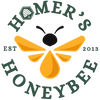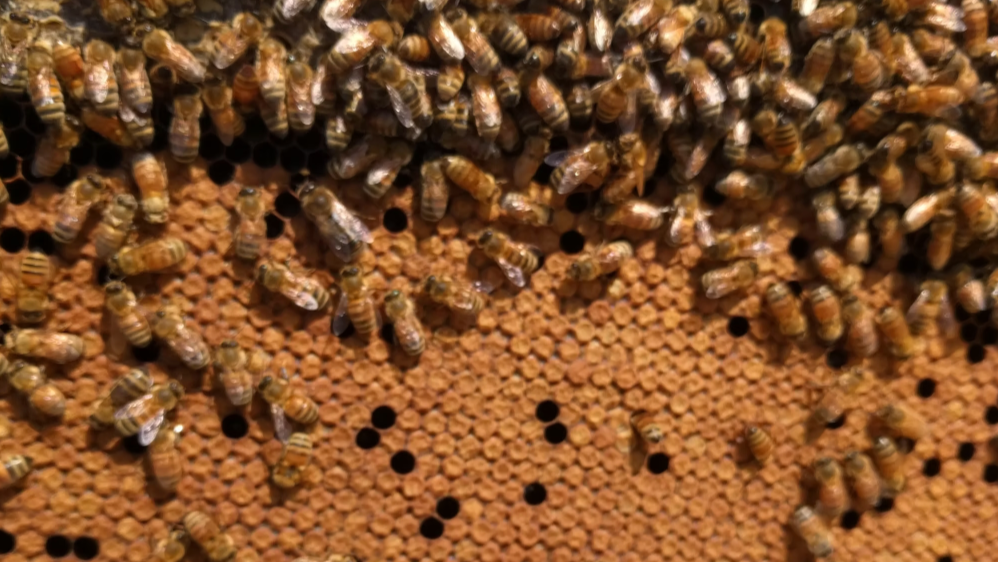Items Needed This Month
-
3rd deep box (Honey Super)
-
Queen excluder (optional)
-
1 Gallon of 1:1 syrup (only if needed)
Items Needed Next Month
-
1:1 Syrup (only if hive is struggling)
-
Read how to raise a new queen early July to replace older queen. (optional)
-
Mite Testing Kit (testing cup, soap solution, 1/2 measuring cup, tub to collect bee sample)
-
OAE mite treatment (if needed)
Action Items
Overwintered
-
Hive inspection every 14 days
-
Check for queen rightness (means you see eggs)
-
Brood status - Is the queen laying a good pattern and is the larvae look healthy? Larvae should look pearly white and wet.
-
They should have plenty of honey and pollen stores. If they are struggling then feed.
-
Monitor for disease or stressors like lack of food, or if you are seeing yellowish or discolored larvae.
-
Monitor that the hive is growing in size and numbers each inspection.
-
Hive Configuration
-
2nd brood box should be full of brood, pollen and honey.
-
1st brood box should have some honey and pollen on the outside frames and mostly brood in the middle frames.
-
Adding 3rd box - You should be adding your honey super on at this point if you have managed your hive well without any early problems. Your 2nd brood box should have a thick crown of honey above the brood or should weigh 80-100 lbs. before adding 3rd box. When adding this box, pull one frame of honey from your 2nd box if your frames are the same size and place it directly in the middle of the honey super. This will help draw the bees up and they will build off of this honey frame.
-
Stop feeding syrup while your honey super is on your hive.
-
Swarm Control - At this point you should have managed your swarm or they already swarmed on you. They shouldn't need or want to swarm again this year as long as you are monitoring their space. Don't let them get honey bound in the bottom 2 boxes this early in the year.
-
Later this month is a great time to raise a new queen right after the summer solstice to replace a 2 year old queen or if queen production is slowing or becoming more spotty. Learn more on June Blog
-
Look at July Action Items to know what to plan for next month.
Newbees
-
Inspect your hive at least every 14 days
-
Checking for eggs means you have a queen. You don't need to see the queen to know she is there if you see eggs. Train your eyes and practice finding those eggs.
-
We want to see a good brood pattern and not a lot of spotty brood. The larvae should be pearly white and wet. If they are dry looking then you want feed them a pollen supplement to help them produce their "bee milk" for the larvae.
-
There should be plenty of pollen and honey.
-
Make sure your hive is growing each time you inspect.
-
Hive Configuration
-
The 2nd box should be close to 80% occupied to add 3rd box
-
You should see brood towards the middle with some pollen surrounding the brood and honey outside of the pollen and outside frames.
-
Adding 3rd box - When the 2nd brood box has a thick crown of honey above the brood and they are occupying 80% or more, then its time to add the honey super. When adding this box, pull one frame of honey from your 2nd box if frames are compatible and place directly in the middle of the honey super. This will help and draw bees up to build off of this honey frame.
-
Stop feeding syrup if you add your honey super (3rd box). But, if you are using new frames then you can add one more gallon of syrup to jump start the wax production. (optional)
-
Remove entrance reducer completely during heavy honey flow.
-
Look at July Action Items to know what to plan for next month.
Mite Treatments
-
No treatment applied this month
It's been a busy bee season thus far. Swarming is finally slowing down and our hives are settling in to preparing for this coming winter. The month of May and June are our heaviest honey flow periods. Things really slow down in July, especially late July, and August unless we get frequent rain storms rolling through, not a high probability here in the Utah Deseret. So if you want a honey crop. It's important to get your hive to the point you can put your honey supers on anytime from Late April or May till the first of June. Supers put on after the middle of June will usually not get very full if used at all. Especially, If the strength of the bee populations is low.
One of my key principals of beekeeping is Queen management. As goes the strength of the queen, goes the strength of the hive. Having a young vigorous queen in the hive will make all the difference in the bee population of the hive, which impacts honey production and cluster size in the winter..
We try to re-queen every year to year and a half. I like to start doing OTS queen re-queening (On The Spot Queen rearing, (details of this method are found in Mel Disselkoen's book "OTS Queen Rearing") 4-5 days after the summer equinox (which is usually around the 21st of June. It's June 20th this year, 2020) Queens raised after the days start to get shorter produce great queens that think it's spring and are vigorous layers through the fall and come out in the critical Spring build up laying hard. The hive is reaching it's peak bee population and the hive usually has lots of food resources packed away. It's late enough that your new queen comes into egg production the first part of August, making her a fall queen, but early enough for them to raise a great Fat winter bee cluster and still be a young vigorous queen in the following spring.
It also creates a break in the brood cycle that will set varroa mites back a bit when they normally would be starting to hit their exponential growth curve. The timing seems to work out perfectly to help the hive re-queen and still get a good honey harvest and have them be in great shape heading into winter.
If you wait for queen failure for the hive to initiate superseding a new queen, Murphy's law says it will happen at the worst possible time due to either low population or poor mating opportunity. Nucs and small population hives will raise queens but a queen raised by a large population hive are better fed and the temperature during incubation more consistent. Hives that raise a supersedure queen, at the right time, make awesome queens. By doing the OTS in early July (the perfect time) you stimulate them to raise a queen when conditions are optimal. (see the results of a new OTS queen in the attached picture. This was an mid August frame of brood.

The Action Items for June are-
-
1, Make sure your hive stays queen right and monitor for Diseases and good hive growth
-
2. Make a plan to re-queen if it wasn't already done in the spring when making splits.
-
3. Manage the honey flow by adding on honey-supers (Deep, or Medium boxes) and giving them space to grow. The equivalent of 3 deep boxes is usually adequate here in Utah.
-
4. Overwintered hives should be monitored for varroa mite build up.
I hope you and your families and your bees are staying safe and healthy. Happy BeeKeeping!

